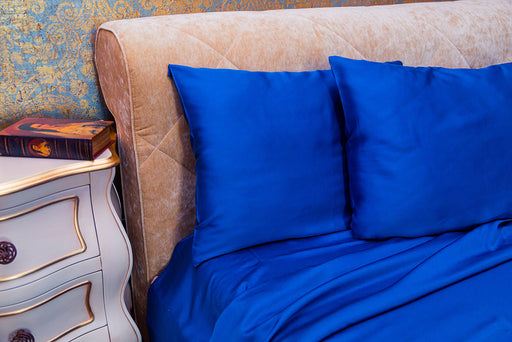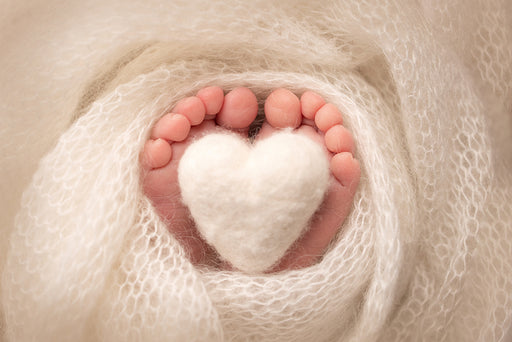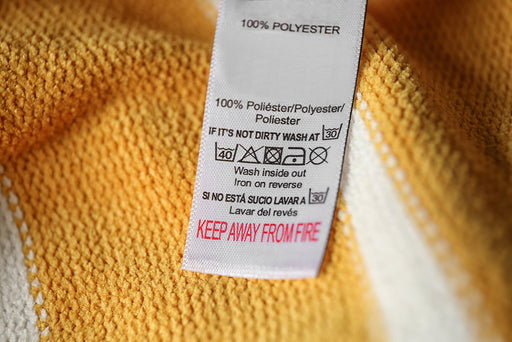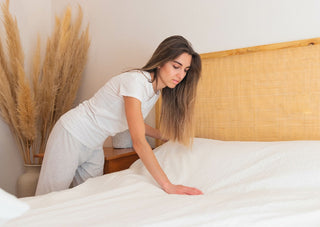Hypoallergenic Bedding for Allergy Relief

If you or anyone in your family suffer from allergies, switching to natural, hypoallergenic fabrics can be very beneficial.
Fabrics and textiles are deemed hypoallergenic if they have been made without the use of harmful chemicals, which can frequently trigger allergies.
Hypoallergenic fabrics are also natural textiles, so in addition to being more ethically produced than synthetic fibres, they are more resistant to saliva and sweat. These fabrics can also be safely washed in hot water, which is better than cold water at killing allergens such as dust mites.
Allergens in Bedding
Dust mite allergies affect roughly 20 million Americans each year, according to the Asthma and Allergy Foundation of America. Unfortunately, bedding is one of the main collectors of these allergens, trapping dander, mildew, and dust mites. Allergens can reside in sheets, pillowcases, comforters and duvet covers, mattress covers and pads, pillows, and mattresses and box springs.
Bedding made from hypoallergenic textiles are better for allergy sufferers because their fabrics are tightly woven and don't trap as many allergens as non-hypoallergenic fabrics.
If you’re ready to make the switch to hypoallergenic bedding, put these four fabrics at the top of your shopping list.
4 Popular Hypoallergenic Fabrics
Silk

In addition to its luxurious feel, silk is also one of the best allergy-fighting bedding fabrics on the market. Silk repels dust mites, is very durable, and wicks moisture, which means it will keep you cool in the summer and warm in the winter. Silk bedding is ideal for delicate skin, like those with eczema or psoriasis, because of its softness.
And, though caring for silk bedding may feel intimidating, knowing how to care for silk properly will extend the life of your bedding and keep it looking pristine.
Bamboo
Bamboo fabric is quickly gaining popularity in apparel and bedding. One of the main reasons for this growth is that bamboo is more environmentally friendly than other fibres because the bamboo plant grows swiftly and does not require fertiliser or pesticide.
Bamboo bedding is favourable for use in the summer because it is naturally moisture wicking. Plus, bamboo fabric is antibacterial and quite durable. The only disadvantage is that bamboo fabric is more expensive than other hypoallergenic options.
If you decide to buy bamboo bedding, examine the packaging carefully before making a purchase. Often, bamboo fabric is blended with rayon, which is made using many chemicals that can irritate your allergies and skin.
Wool
In winter months, wool can be perfect for bedding. It's cozy, dust mite-proof, antimicrobial, and breathable. It also absorbs up to 33% of its own weight in moisture without feeling damp. By minimizing moisture, wool helps to prevent skin irritations such as rashes, itchy skin, and eczema. Wool also contains lanolin, which helps to keep your skin healthy. Contrary to popular belief, this natural fabric is also machine washable, but always check the care label first. Wool is an excellent fabric for rugs and mattress pads, and alpaca and sheep wool blends produce superior bedding.

And, whether you prefer to DIY or enlist the help of professional cleaners, cleaning wool bedding correctly will allow you to enjoy your wool bedding for years to come.
Linen
Linen is not only hypoallergenic, but also antimicrobial. It even naturally repels static, which eliminates the need for fabric softener or dryer sheets, which are another major allergy carrier. Plus, linen absorbs up to 20% of moisture before becoming damp. In fact, it gets stronger when wet, so it won’t be damaged in the washing machine.
Linen is a popular choice for sheets and bedding in warmer climates, because it is breathable and fast-drying. And, because linen is porous, it keeps you warm in the winter.
With so many benefits, linen is in high demand as one of the most popular sustainable fabrics.
Regardless of what hypoallergenic fabric you choose, pay close attention to each item’s pore size, which is the size of the space between the stitches of the fabric. The smaller the pore size, the better it will guard against allergens. Pore size is measured in microns; look for bedding with a pore size of 10 microns or less.
FAQs
What are hypoallergenic fabrics?
Hypoallergenic fabrics are made without the use of harmful chemicals, and they are natural textiles, which means they are better for the environment and more ethically produced than synthetic fibres. These fabrics are tightly knitted and moisture resistant. They can be safely washed in hot water, which is better than cold water at killing allergens.
Is cotton naturally hypoallergenic?
Cotton is a popular hypoallergenic fabric, particularly for use with newborns and infants. Items made with 100% organic cotton are more environmentally friendly and are ideal for eczema or psoriasis sufferers. High quality cotton is dust-mite resistant and is easy to clean.
Is polyester hypoallergenic?

Polyester is a synthetic textile produced by combining petroleum-derived ethylene glycol and purified terephthalic acid polymerised. This substance is melted to make polyethylene terephthalate, which is then turned into the polyester. Polyester and disposable, plastic water bottles are made with the same chemicals. All synthetic fabrics are made using similar types of chemical processes. None of these synthetics are considered hypoallergenic fabrics.
What does hypoallergenic mean?
Hypoallergenic is a general claim that implies a product will be less likely to cause allergic reactions. Not all hypoallergenic products, however, are made equal. Cosmetics, clothing, toys, and even pets, can be labeled hypoallergenic without having to meet any official standards. The Food and Drug Administration (FDA) states that “There are no federal standards or definitions that govern the use of the term ‘hypoallergenic.’”
For the many people suffering from allergies, switching to hypoallergenic fabrics, specifically bedding, is something to consider in addition to conventional treatments.
Other good changes to the bedroom environment that combat allergies include:
Diffusing essential oils such as lavender, peppermint, and eucalyptus
Purchasing an air purifier to remove dust, pollen, and other particles from the air
Keeping windows closed to protect your indoor air
With these suggestions and the shift to hypoallergenic bedding, allergy sufferers can reduce the chance of having a reaction at night, and, at the same time, protect the environment.

About MothPrevention
MothPrevention® speak to customers every day about their clothes moth issues - clothes moths are a species that are ever increasing and that can cause significant damage to clothes, carpets and other home textiles.
To date, we’ve helped over 250,000 customers deal with their moth problems. We have developed professional grade solutions including proprietary pheromones and trap design engineered to the highest production standards.





